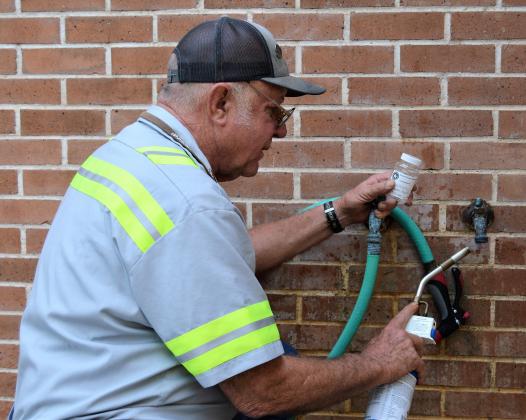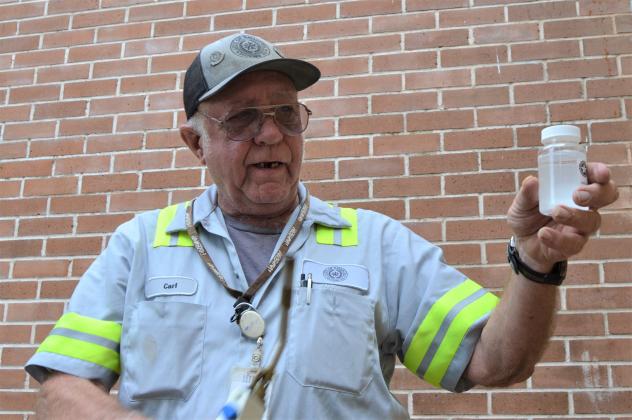“Superior” water rating not left to chance
Part 3 of 4: Testing the waters
Navasota’s public water supply is tested by licensed water utility employees as well as a third- party testing lab at the Brazos County Health Department (BCHD), for the Texas Commission on Environmental Quality (TCEQ). So, what’s added to Navasota city water and how do we know it’s safe?
Random sampling
Turning on the tap to clean water begins with well water in the groundwater storage tank on Malcolm Street. It feeds the city’s two elevated tanks on Allen and Oakwood Streets. From there, the water goes through the city’s distribution system and the only chemical added to Navasota water is chlorine, used as a disinfectant.
Utilities Director Jeff Greer said, “If by some chance something did get into the groundwater, you’ve got a lot of people sick. For a public water supply, you have to disinfect the water according to state standards.”
Greer explained that nine samples are taken each month over a two-day period from the same nine locations throughout the city. These include residences, a hospital and other sites determined by TCEQ.
Greer said, “TCEQ wants to know where we’re sampling. They want to make sure the water is the same everywhere. We’re taking samples from all over. You’ve got low pressure sites, high pressure sites…TCEQ wants to make sure it’s equal at the sampling locations.”
Licensed city water operators test for chlorine, total coliform and E-Coli. TCEQ will notify the City if any of the three contaminants are present in the samples and how the public should be notified.
Testing
Sampling is a very precise process. Dropping the test lid on the ground, airborne matter like pollen or dust, or touching the sample with a thumb can contaminate a sample and explains the need for multiple samples from multiple locations.
Class C Water Operator Carl Pullin said, “Bacteria flies in the air and can give you a bad sample. If I have a bad sample, I have to take repeat samples, one at the site, one within five connections above and five connections below, and I have to check all the wells.”
Before sampling, the water is allowed to run a sufficient amount of time to receive fresh water from the line, and the faucet is torched to make sure nothing on the outside can contaminate the sample.
After testing for the chlorine level, a water sample from the flowing faucet goes directly into a test bottle provided by BCHD.
Pullin said, “I have to get it right at the line (on the bottle). The amount of water has to be exact. If I have too much over that line or under that line, they won’t take the sample and will send it back.”
The sealed sample bottle contains crystals that neutralize the chlorine, so it doesn’t interfere with testing for fecal coliform and E-coli.
The test bottle is sealed, placed on ice and the process is repeated at each testing location. The samples are then delivered to BCHD for testing which takes 24 hours.
According to Greer, if three or four bad samples show up,” We need to get a water notice out right away.”
A TCEQ contractor makes a scheduled visit annually, or may come unannounced in response to a complaint, and pull random samples. The contractor is accompanied by water utility staff who are not allowed to come in contact with the samples.
TCEQ tests for 205 constituents that include contaminants like arsenic, benzene, literally from A - X. For the National Primary Drinking Water Regulations list of contaminants, potential health effects, common source of contaminant and public health goal, go to: www.epa.gov/ground-water-and-drinking-water/national-primary-drinking-water-regulations.
Free testing for water users
Utility Administrative Assistant Jennifer Reyna advised that customers with concerns about their water may obtain sample bottles from the BCHD and have their water tested free of charge. She said most requests have come from out of the Navasota water district.
Navasota’s Annual Water Quality Report is distributed by Reyna in customers’ utility bills and is available online at www.navasotatx.gov. and provides the contaminants tested and the test results.
Annual notification is required by the Texas Commission of Environmental Quality (TCEQ) thanks to the 1996 Safe Drinking Water Act, and for the period Jan. 1 – Dec. 31, 2018, Navasota’s drinking water was rated “Superior” by the TCEQ, meeting all state and federal standards.
Next week: Part 4, “Maintaining safe water”


